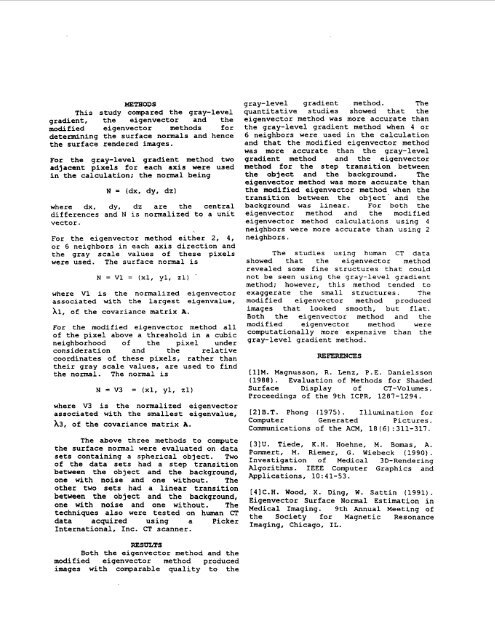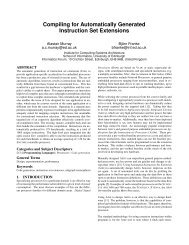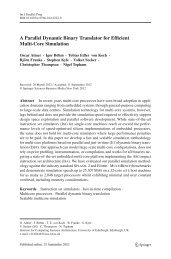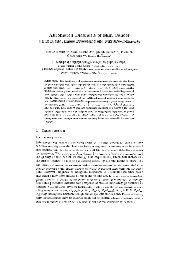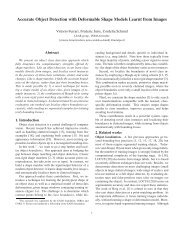Estimation of surface normals for use in 3D rendering ... - IEEE Xplore
Estimation of surface normals for use in 3D rendering ... - IEEE Xplore
Estimation of surface normals for use in 3D rendering ... - IEEE Xplore
Create successful ePaper yourself
Turn your PDF publications into a flip-book with our unique Google optimized e-Paper software.
METHODS<br />
This study compared the gray-level<br />
gradient, the eigenvector and the<br />
modified eigenvector methods <strong>for</strong><br />
determ<strong>in</strong><strong>in</strong>g the <strong>surface</strong> <strong>normals</strong> and hence<br />
the <strong>surface</strong> rendered images.<br />
For the gray-level gradient method two<br />
adjacent pixels <strong>for</strong> each axis were <strong>use</strong>d<br />
<strong>in</strong> the calculation; the normal be<strong>in</strong>g<br />
N = (dx, dy, dz)<br />
where dx, dy, dz are the central<br />
differences and N is normalized to a unit<br />
vector.<br />
For the eigenvector method either 2, 4,<br />
or 6 neighbors <strong>in</strong> each axis direction and<br />
the gray scale values <strong>of</strong> these pixels<br />
were <strong>use</strong>d. The <strong>surface</strong> normal is<br />
N = V1 = (XI, yl, 21) '<br />
where V1 is the normalized eigenvector<br />
associated with the largest eigenvalue,<br />
11, <strong>of</strong> the covariance matrix A.<br />
For the modified eigenvector method all<br />
<strong>of</strong> the pixel above a threshold <strong>in</strong> a cubic<br />
neighborhood <strong>of</strong> the pixel under<br />
consideration and the re 1 at i ve<br />
coord<strong>in</strong>ates <strong>of</strong> these pixels, rather than<br />
their gray scale values, are <strong>use</strong>d to f<strong>in</strong>d<br />
the normal. The normal is<br />
N = V3 = (xl, yl, zl)<br />
where V3 is the normalized eigenvector<br />
associated with the smallest eigenvalue,<br />
h, <strong>of</strong> the covariance matrix A.<br />
The above three methods to compute<br />
the <strong>surface</strong> normal were evaluated on data<br />
sets conta<strong>in</strong><strong>in</strong>g a spherical object. Two<br />
<strong>of</strong> the data sets had a step transition<br />
between the object and the background,<br />
one with noise and one without. The<br />
other two sets had a l<strong>in</strong>ear transition<br />
between the object and the background,<br />
one with noise and one without. The<br />
techniques also were tested on human CT<br />
data acquired us<strong>in</strong>g a Picker<br />
International, Inc. CT scanner.<br />
RESULTS<br />
Both the eigenvector method and the<br />
modified eigenvector method produced<br />
images with comparable quality to the<br />
gray-level gradient method. The<br />
quantitative studies showed that the<br />
eigenvector method was more accurate than<br />
the gray-level gradient method when 4 or<br />
6 neighbors were <strong>use</strong>d <strong>in</strong> the calculation<br />
and that the modified eigenvector method<br />
was more accurate than the gray-level<br />
gradient method and the eigenvector<br />
method <strong>for</strong> the step transition between<br />
the object and the background. The<br />
eigenvector method was more accurate than<br />
the modified eigenvector method when the<br />
transition between the object' and the<br />
background was l<strong>in</strong>ear. For both the<br />
eigenvector method and the modified<br />
eigenvector method calculations us<strong>in</strong>g 4<br />
neighbors were more accurate than us<strong>in</strong>g 2<br />
neighbors.<br />
The studies us<strong>in</strong>g human CT data<br />
showed that the eigenvector method<br />
revealed some f<strong>in</strong>e structures that could<br />
not be seen us<strong>in</strong>g the gray-level gradient<br />
method; however, this method tended to<br />
exaggerate the small structures. The<br />
modified eigenvector method produced<br />
images that looked smooth, but flat.<br />
Both the eigenvector method and the<br />
modified eigenvector method were<br />
computationally more expensive than the<br />
gray-level gradient method.<br />
REFERENCES<br />
[lIM. Magnusson, R. Lenz, P.E. Danielsson<br />
(1988). Evaluation <strong>of</strong> Methods <strong>for</strong> Shaded<br />
Surface Display <strong>of</strong> CT-Volumes.<br />
Proceed<strong>in</strong>gs <strong>of</strong> the 9th ICPR, 1287-1294.<br />
121 B.T. Phong (1975) . Illum<strong>in</strong>ation <strong>for</strong><br />
Computer Generated Pictures.<br />
Communications <strong>of</strong> the ACM, 18(6) :311-317.<br />
[SlU. Tiede, K.H. Hoehne, M. Bomas, A.<br />
Pommert, M. Riemer, G. Wiebeck (1990).<br />
Investigation <strong>of</strong> Medical <strong>3D</strong>-Render<strong>in</strong>g<br />
Algorithms. <strong>IEEE</strong> Computer Graphics and<br />
Applications, 10:41-53.<br />
[4]C.H. Wood, X. D<strong>in</strong>g, W. Satt<strong>in</strong> (1991).<br />
Eigenvector Surface Normal <strong>Estimation</strong> <strong>in</strong><br />
Medical Imag<strong>in</strong>g. 9th Annual Meet<strong>in</strong>g <strong>of</strong><br />
the Society <strong>for</strong> Magnetic Resonance<br />
Imag<strong>in</strong>g, Chicago, IL.


